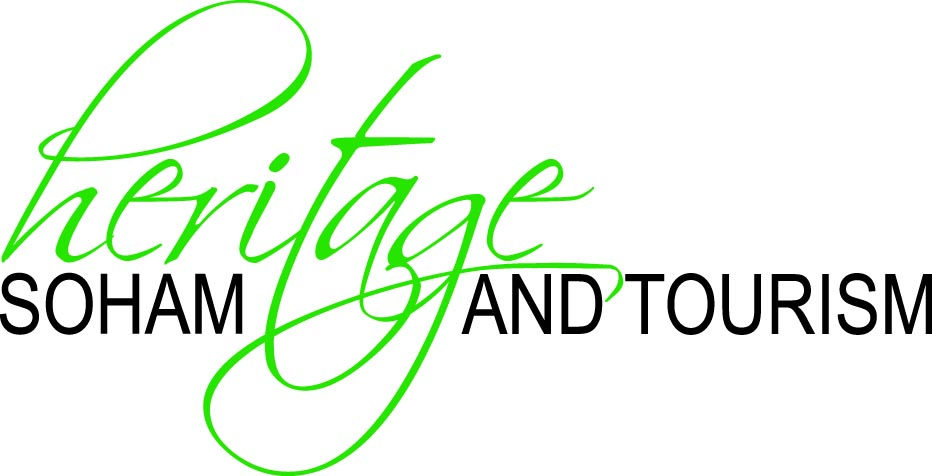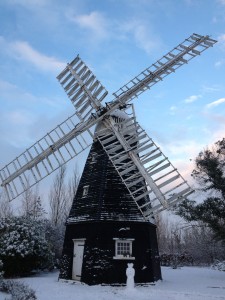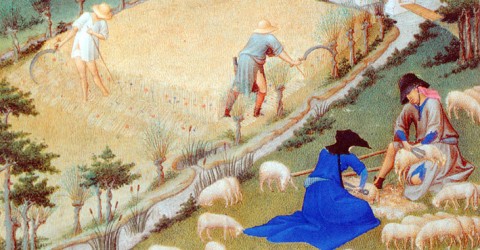
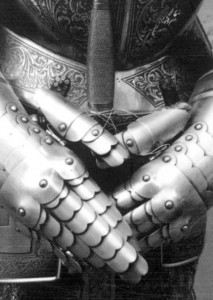 As the Saxons invaded East Anglia the Iceni apparently withdrew to Soham and provided a Christian refuge for St Felix when he arrived in 653AD, to Christianise the East Angles. Soham was the first see of the Bishops of East Anglia. A situation regularised by the marriage of Etheldreda to Tonbert the last King of the Iceni. The first cathedral was founded here; subsequently moved to Ely about 820AD. The populace had gone to Soham Mereside to trade. The Danes changed the prows of their ships; could sail in and slaughtered the people, monks and sacked the monastic buildings. The manorial lands themselves, were settled by the Crown before the Norman Conquest and are documented in the Domesday Book. Soham is situated six and two thirds of a mile from Ely and Newmarket, because this is as far as a man could ride in a day to set up a fresh market. Soham’s market was apparently the first in the area. The statute ‘Quia Emptores’ of 1290, which still remains in force today, states that ‘no Lordship of the Manor can have a valid existence unless it existed prior to 1290’ when the act came into force. Not only did the manor of Soham pre date 1290, it did in fact predate the Conquest, and was even recorded in a visit and stay here by King Canute (in preference to Ely) –‘on skates proceeded by a fat man called Budde – (Pudding) as he crossed Soham. A Saxon carol records that as he followed the fat man over the Mere the monks of Ely sang loudly to no avail.
As the Saxons invaded East Anglia the Iceni apparently withdrew to Soham and provided a Christian refuge for St Felix when he arrived in 653AD, to Christianise the East Angles. Soham was the first see of the Bishops of East Anglia. A situation regularised by the marriage of Etheldreda to Tonbert the last King of the Iceni. The first cathedral was founded here; subsequently moved to Ely about 820AD. The populace had gone to Soham Mereside to trade. The Danes changed the prows of their ships; could sail in and slaughtered the people, monks and sacked the monastic buildings. The manorial lands themselves, were settled by the Crown before the Norman Conquest and are documented in the Domesday Book. Soham is situated six and two thirds of a mile from Ely and Newmarket, because this is as far as a man could ride in a day to set up a fresh market. Soham’s market was apparently the first in the area. The statute ‘Quia Emptores’ of 1290, which still remains in force today, states that ‘no Lordship of the Manor can have a valid existence unless it existed prior to 1290’ when the act came into force. Not only did the manor of Soham pre date 1290, it did in fact predate the Conquest, and was even recorded in a visit and stay here by King Canute (in preference to Ely) –‘on skates proceeded by a fat man called Budde – (Pudding) as he crossed Soham. A Saxon carol records that as he followed the fat man over the Mere the monks of Ely sang loudly to no avail.
In 1372 the manor was granted to John – Duke of Lancaster (the future King Henry 4th) and in 1459 all manors were made a parcel of the Duchy, regularly referred to as ‘Soham and Fordham’, along with some other smaller manors which had all returned to the crown under King Henry IV in 1399. Duke Brithnoth also had a small manor in Soham, given to the Abbot and Convent of Ely in 991AD. Other smaller manors passed to the Tiptoft family (Earls of Worcester) descending to female heirs, eventually taking the name of Netherhall Wygorne. In 1685 the Crown sold the manors to Sir Thomas Chicheley, allotting 115 acres for the use of the poor and the founding of a grammar school. He abandoned attempts to recover the ancient field strips. One and a quarter acres is as much as a horse can plough in a day.
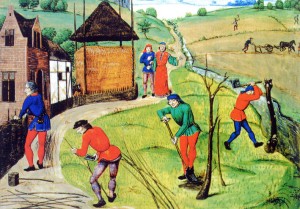 The oldest field map in the county archives, is one of the strip fields. He brought lands from various non manorial holdings, taking over the North East Fen allotments thus creating a landholding of 3,300 acres. My grandfather told me as a young man, he rode on his horse from Wicken to Fordham to Soham to vote asa small landholder in all three parishes. I keep the last strip field for educational purposes. Owning twelve acres of strip field entitles you to graze a horse on the Horse Fens for the summer. When I was a young man the boundaries of many of these fields were curved, because an ox could not plough straight as a tractor is able. The Fen Reeves have records back over the centuries, and record the annual letting each May. Following the death of Thomas Chicheley, the manors went to his widow and eventually to his son John who died in 1718. In 1719 they then passed to his brother in law Edward Hughes, the representative of Edward Harrison, of the East India Company. The manor was inherited on his death by his daughter Audrey’s husband Charles Townsend. Charles had succeeded his father as Viscount in 1738. On Charles death it descended to his son in 1764 then again to his son George who was created a Marquess in 1787. The lordships and remaining estate were then sold to Thomas Devlis of Kettlesey, Norfolk and immediately acquired by William Dunn Gardner. William had married his only daughter Sarah, at the tender age of twelve, to the next Marquis Townsend’s son and successor. He then settled the manor and manorial farms on her husband for a life interest. He remained her ‘nominal husband’ until his death in 1856.The manor passed to Sarah’s eldest son, not by her husband, which he then passed to his surviving son.
The oldest field map in the county archives, is one of the strip fields. He brought lands from various non manorial holdings, taking over the North East Fen allotments thus creating a landholding of 3,300 acres. My grandfather told me as a young man, he rode on his horse from Wicken to Fordham to Soham to vote asa small landholder in all three parishes. I keep the last strip field for educational purposes. Owning twelve acres of strip field entitles you to graze a horse on the Horse Fens for the summer. When I was a young man the boundaries of many of these fields were curved, because an ox could not plough straight as a tractor is able. The Fen Reeves have records back over the centuries, and record the annual letting each May. Following the death of Thomas Chicheley, the manors went to his widow and eventually to his son John who died in 1718. In 1719 they then passed to his brother in law Edward Hughes, the representative of Edward Harrison, of the East India Company. The manor was inherited on his death by his daughter Audrey’s husband Charles Townsend. Charles had succeeded his father as Viscount in 1738. On Charles death it descended to his son in 1764 then again to his son George who was created a Marquess in 1787. The lordships and remaining estate were then sold to Thomas Devlis of Kettlesey, Norfolk and immediately acquired by William Dunn Gardner. William had married his only daughter Sarah, at the tender age of twelve, to the next Marquis Townsend’s son and successor. He then settled the manor and manorial farms on her husband for a life interest. He remained her ‘nominal husband’ until his death in 1856.The manor passed to Sarah’s eldest son, not by her husband, which he then passed to his surviving son.
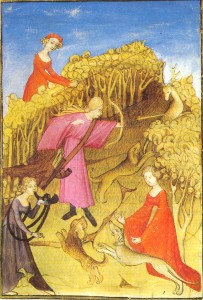 During the 1800’sthe Dunn Gardner stewards treated the manors of Soham and Fordham as one entity, because Netherhall Wygorne crossed the Parish boundaries. So now we begin the current stages of manorial ownership. In 1974 Mr Timothy Clark purchased Nethehall Wygorne and Fordham from Miriam Leader, nee Dunn Gardiner, with the understanding that he preserves the remains of one of the few unenclosed manors in the country. It is distressing that the Shade Common, ploughed during the war has not been returned to the people of Soham, with the Act of Administration imposed by the old Newmarket Rural District Council, having never been signed by Mrs Leader or Timothy Clark. In 1980 the Commons Administration Committee settled the remains of the manorial lands to Mr Clark. He has subsequently managed to gain S.S.S.I. status to preserve the five orchid species on the wet Horse Fen and Nature Conservancy consider the hedgerows to be the oldest in the country and probably date to before 900AD. Mr Clark has endeavoured to maintain the use of the common land for all the people of Soham now that there are no longer any townsfolk with common rights. To have common right it was necessary to be an adult resident of Soham and an income of less than £12 per annum. This would enable you to graze one cow, three sheep and six geese for the summer! Article by kind permission of Mr Timothy Clark – Lord of the Manor.
During the 1800’sthe Dunn Gardner stewards treated the manors of Soham and Fordham as one entity, because Netherhall Wygorne crossed the Parish boundaries. So now we begin the current stages of manorial ownership. In 1974 Mr Timothy Clark purchased Nethehall Wygorne and Fordham from Miriam Leader, nee Dunn Gardiner, with the understanding that he preserves the remains of one of the few unenclosed manors in the country. It is distressing that the Shade Common, ploughed during the war has not been returned to the people of Soham, with the Act of Administration imposed by the old Newmarket Rural District Council, having never been signed by Mrs Leader or Timothy Clark. In 1980 the Commons Administration Committee settled the remains of the manorial lands to Mr Clark. He has subsequently managed to gain S.S.S.I. status to preserve the five orchid species on the wet Horse Fen and Nature Conservancy consider the hedgerows to be the oldest in the country and probably date to before 900AD. Mr Clark has endeavoured to maintain the use of the common land for all the people of Soham now that there are no longer any townsfolk with common rights. To have common right it was necessary to be an adult resident of Soham and an income of less than £12 per annum. This would enable you to graze one cow, three sheep and six geese for the summer! Article by kind permission of Mr Timothy Clark – Lord of the Manor.
Commons in Soham A list of the common land existing in 1889. The information is from an extract from the Soham Parochial Magazine.
Qua Fen Common – At Town End on east side East Fen Common – South of the Weatheralls Burgess Corner – Between Qua Fen Common and the Weatheralls The Shade – West side of Ely road, beyond Town End Angle Common – East of Soham Mere, due West of Moat Gardens First Pen and Back Pen – South east of Angle Common adjoining the Lode Broad Piece – South of the Shade and between it and the Lode.
